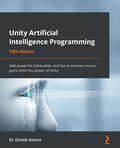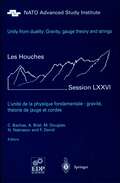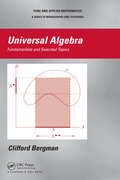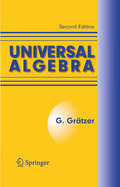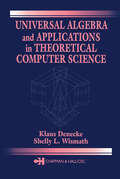- Table View
- List View
Units in Skew Fields (Progress in Mathematics #186)
by Ernst KleinertThis book is devoted to a study of the unit groups of orders in skew fields, finite dimensional and central over the rational field; it thereby belongs to the field of noncommutative arithmetic. Its purpose is a synopsis of results and methods, including full proofs of the most important results. It is addressed to researchers in number theory and arithmetic groups.
Unity 2020 Virtual Reality Projects: Learn VR development by building Immersive applications and games with Unity 2019. 4 and later versions
by Jonathan LinowesThis third edition of the Unity Virtual Reality (VR) development guide is updated to cover the latest features of Unity 2019.4 or later versions - the leading platform for building VR games, applications, and immersive experiences for contemporary VR devices. Enhanced with more focus on growing components, such as Universal Render Pipeline (URP), extended reality (XR) plugins, the XR Interaction Toolkit package, and the latest VR devices, this edition will help you to get up to date with the current state of VR. With its practical and project-based approach, this book covers the specifics of virtual reality development in Unity. You'll learn how to build VR apps that can be experienced with modern devices from Oculus, VIVE, and others. This virtual reality book presents lighting and rendering strategies to help you build cutting-edge graphics, and explains URP and rendering concepts that will enable you to achieve realism for your apps. You'll build real-world VR experiences using world space user interface canvases, locomotion and teleportation, 360-degree media, and timeline animation, as well as learn about important VR development concepts, best practices, and performance optimization and user experience strategies. By the end of this Unity book, you'll be fully equipped to use Unity to develop rich, interactive virtual reality experiences.
Unity Artificial Intelligence Programming: Add Powerful, Believable, And Fun Ai Entities In Your Game With The Power Of Unity
by Davide AversaAdd powerful, believable, and fun AI entities in your game with the power of Unity
Unity Certified Programmer Exam Guide: Pass The Unity Certification Exam With The Help Of Expert Tips And Techniques
by Philip WalkerPass the Unity certification exam with the help of expert tips and techniques
Unity from Diversity: Pluralist Systemic Thinking for Social and Behavioural Research
by Ray W. CookseyThis book is about the choices that researchers can make when building knowledge in social and behavioural spaces. Knowledge is the unity we seek and, given that social and behavioural research is a human endeavour focusing on human lives and experiences, there are diverse and ever-evolving pathways towards achieving that unity. Any one pathway will only ever yield partial glimpses into human life and diversity of potential choices serves to enrich, expand, and enlarge those glimpses in pursuit of more complete understanding. The book shows that researchers and the researched are far more connected than disconnected in this world and those connections are spread out through a network of interlinked complex systems. The book argues that pluralist systemic thinking provides the means by which a researcher’s methodological choices for navigating the ‘Data Triangle’ (comprising data source, data gathering, and data analysis strategies) and the learning they provide can be fully and robustly contextualised with respect to those systems and the expectations and influences that emerge from them. Such contextualisations facilitate the refinement, augmentation, and/or narrowing of those choices during the researcher’s journey. Anticipating choices downstream may have implications for more immediate choices and more immediate choices may create a cascade of necessary downstream choices. An essential part of contextualisation involves making choices about patterns of guiding assumptions, modes of knowledge building, and research frames. Researchers must develop the capacity to be flexible and adapt to unanticipated emergent events, obstacles, and political influences, making trade-offs where necessary throughout their research journey, always with an eye on both feasibility and quality. Importantly, research has no meaning unless the researcher can ensure that it connects with intended audiences via specific research outcomes, especially since the ultimate judgments about the convincingness, meaningfulness, quality, and utility of the research are vested in those audiences. Throughout the book, special attention is devoted to the role(s) that stakeholders and gatekeepers play in shaping the researcher’s journey as well as to what can be learned from Indigenous/First Nations perspectives on social and behavioural research.
Unity from Duality: Les Houches Session LXXVI, July 30 - August 31, 2001 (Les Houches - Ecole d'Ete de Physique Theorique #76)
by Constantin P. Bachas Adel Bilal Michael R. Douglas Nikita A. Nekrasov Francois DavidThe contributions to this volume of the famous summer school in Les Houches cover the recent developments in supersymmetric string theory, the gauge theory/string theory correspondence and string duality. The book is a comprehensive introduction to the recent developments in string/M-theory and quantum gravity.
The Unity of Mathematics: In Honor of the Ninetieth Birthday of I.M. Gelfand (Progress in Mathematics #244)
by Pavel Etingof Vladimir S Retakh I. M. SingerTribute to the vision and legacy of Israel Moiseevich Gel'fand Written by leading mathematicians, these invited papers reflect the unity of mathematics as a whole, with particular emphasis on the many connections among the fields of geometry, physics, and representation theory Topics include conformal field theory, K-theory, noncommutative geometry, gauge theory, representations of infinite-dimensional Lie algebras, and various aspects of the Langlands program
Univalent Functions and Conformal Mapping: Reihe: Moderne Funktionentheorie (Ergebnisse der Mathematik und ihrer Grenzgebiete. 2. Folge #18)
by James A. JenkinsThis monograph deals with the application of the method of the extremal metric to the theory of univalent functions. Apart from an introductory chapter in which a brief survey of the development of this theory is given there is therefore no attempt to follow up other methods of treatment. Nevertheless such is the power of the present method that it is possible to include the great majority of known results on univalent functions. It should be mentioned also that the discussion of the method of the extremal metric is directed toward its application to univalent functions, there being no space to present its numerous other applications, particularly to questions of quasiconformal mapping. Also it should be said that there has been no attempt to provide an exhaustive biblio graphy, reference normally being confined to those sources actually quoted in the text. The central theme of our work is the General Coefficient Theorem which contains as special cases a great many of the known results on univalent functions. In a final chapter we give also a number of appli cations of the method of symmetrization. At the time of writing of this monograph the author has been re ceiving support from the National Science Foundation for which he wishes to express his gratitude. His thanks are due also to Sister BARBARA ANN Foos for the use of notes taken at the author's lectures in Geo metric Function Theory at the University of Notre Dame in 1955-1956.
Univalent Functions and Conformal Mapping (Ergebnisse der Mathematik und Ihrer Grenzgebiete. 1. Folge #18)
by James Allister JenkinsUnivariate and Multivariate General Linear Models: Theory and Applications with SAS, Second Edition (Statistics: Textbooks and Monographs)
by Kevin KimReviewing the theory of the general linear model (GLM) using a general framework, Univariate and Multivariate General Linear Models: Theory and Applications with SAS, Second Edition presents analyses of simple and complex models, both univariate and multivariate, that employ data sets from a variety of disciplines, such as the social and behavioral
Univariate and Multivariate General Linear Models: Theory and Applications with SAS, Second Edition
by Kevin Kim Neil TimmReviewing the theory of the general linear model (GLM) using a general framework, Univariate and Multivariate General Linear Models: Theory and Applications with SAS, Second Edition presents analyses of simple and complex models, both univariate and multivariate, that employ data sets from a variety of disciplines, such as the social and behavioral
Univariate, Bivariate, and Multivariate Statistics Using R: Quantitative Tools for Data Analysis and Data Science
by Daniel J. DenisA practical source for performing essential statistical analyses and data management tasks in R Univariate, Bivariate, and Multivariate Statistics Using R offers a practical and very user-friendly introduction to the use of R software that covers a range of statistical methods featured in data analysis and data science. The author— a noted expert in quantitative teaching —has written a quick go-to reference for performing essential statistical analyses and data management tasks in R. Requiring only minimal prior knowledge, the book introduces concepts needed for an immediate yet clear understanding of statistical concepts essential to interpreting software output. The author explores univariate, bivariate, and multivariate statistical methods, as well as select nonparametric tests. Altogether a hands-on manual on the applied statistics and essential R computing capabilities needed to write theses, dissertations, as well as research publications. The book is comprehensive in its coverage of univariate through to multivariate procedures, while serving as a friendly and gentle introduction to R software for the newcomer. This important resource: Offers an introductory, concise guide to the computational tools that are useful for making sense out of data using R statistical software Provides a resource for students and professionals in the social, behavioral, and natural sciences Puts the emphasis on the computational tools used in the discovery of empirical patterns Features a variety of popular statistical analyses and data management tasks that can be immediately and quickly applied as needed to research projects Shows how to apply statistical analysis using R to data sets in order to get started quickly performing essential tasks in data analysis and data science Written for students, professionals, and researchers primarily in the social, behavioral, and natural sciences, Univariate, Bivariate, and Multivariate Statistics Using R offers an easy-to-use guide for performing data analysis fast, with an emphasis on drawing conclusions from empirical observations. The book can also serve as a primary or secondary textbook for courses in data analysis or data science, or others in which quantitative methods are featured.
Univariate, Bivariate, and Multivariate Statistics Using R: Quantitative Tools for Data Analysis and Data Science
by Daniel J. DenisA practical source for performing essential statistical analyses and data management tasks in R Univariate, Bivariate, and Multivariate Statistics Using R offers a practical and very user-friendly introduction to the use of R software that covers a range of statistical methods featured in data analysis and data science. The author— a noted expert in quantitative teaching —has written a quick go-to reference for performing essential statistical analyses and data management tasks in R. Requiring only minimal prior knowledge, the book introduces concepts needed for an immediate yet clear understanding of statistical concepts essential to interpreting software output. The author explores univariate, bivariate, and multivariate statistical methods, as well as select nonparametric tests. Altogether a hands-on manual on the applied statistics and essential R computing capabilities needed to write theses, dissertations, as well as research publications. The book is comprehensive in its coverage of univariate through to multivariate procedures, while serving as a friendly and gentle introduction to R software for the newcomer. This important resource: Offers an introductory, concise guide to the computational tools that are useful for making sense out of data using R statistical software Provides a resource for students and professionals in the social, behavioral, and natural sciences Puts the emphasis on the computational tools used in the discovery of empirical patterns Features a variety of popular statistical analyses and data management tasks that can be immediately and quickly applied as needed to research projects Shows how to apply statistical analysis using R to data sets in order to get started quickly performing essential tasks in data analysis and data science Written for students, professionals, and researchers primarily in the social, behavioral, and natural sciences, Univariate, Bivariate, and Multivariate Statistics Using R offers an easy-to-use guide for performing data analysis fast, with an emphasis on drawing conclusions from empirical observations. The book can also serve as a primary or secondary textbook for courses in data analysis or data science, or others in which quantitative methods are featured.
Univariate Discrete Distributions (Wiley Series in Probability and Statistics #444)
by Norman L. Johnson Adrienne W. Kemp Samuel KotzThis Set Contains: Continuous Multivariate Distributions, Volume 1, Models and Applications, 2nd Edition by Samuel Kotz, N. Balakrishnan and Normal L. Johnson Continuous Univariate Distributions, Volume 1, 2nd Edition by Samuel Kotz, N. Balakrishnan and Normal L. Johnson Continuous Univariate Distributions, Volume 2, 2nd Edition by Samuel Kotz, N. Balakrishnan and Normal L. Johnson Discrete Multivariate Distributions by Samuel Kotz, N. Balakrishnan and Normal L. Johnson Univariate Discrete Distributions, 3rd Edition by Samuel Kotz, N. Balakrishnan and Normal L. Johnson Discover the latest advances in discrete distributions theory The Third Edition of the critically acclaimed Univariate Discrete Distributions provides a self-contained, systematic treatment of the theory, derivation, and application of probability distributions for count data. Generalized zeta-function and q-series distributions have been added and are covered in detail. New families of distributions, including Lagrangian-type distributions, are integrated into this thoroughly revised and updated text. Additional applications of univariate discrete distributions are explored to demonstrate the flexibility of this powerful method. A thorough survey of recent statistical literature draws attention to many new distributions and results for the classical distributions. Approximately 450 new references along with several new sections are introduced to reflect the current literature and knowledge of discrete distributions. Beginning with mathematical, probability, and statistical fundamentals, the authors provide clear coverage of the key topics in the field, including: Families of discrete distributions Binomial distribution Poisson distribution Negative binomial distribution Hypergeometric distributions Logarithmic and Lagrangian distributions Mixture distributions Stopped-sum distributions Matching, occupancy, runs, and q-series distributions Parametric regression models and miscellanea Emphasis continues to be placed on the increasing relevance of Bayesian inference to discrete distribution, especially with regard to the binomial and Poisson distributions. New derivations of discrete distributions via stochastic processes and random walks are introduced without unnecessarily complex discussions of stochastic processes. Throughout the Third Edition, extensive information has been added to reflect the new role of computer-based applications. With its thorough coverage and balanced presentation of theory and application, this is an excellent and essential reference for statisticians and mathematicians.
Univariate Stable Distributions: Models for Heavy Tailed Data (Springer Series in Operations Research and Financial Engineering)
by John P. NolanThis textbook highlights the many practical uses of stable distributions, exploring the theory, numerical algorithms, and statistical methods used to work with stable laws. Because of the author’s accessible and comprehensive approach, readers will be able to understand and use these methods. Both mathematicians and non-mathematicians will find this a valuable resource for more accurately modelling and predicting large values in a number of real-world scenarios.Beginning with an introductory chapter that explains key ideas about stable laws, readers will be prepared for the more advanced topics that appear later. The following chapters present the theory of stable distributions, a wide range of applications, and statistical methods, with the final chapters focusing on regression, signal processing, and related distributions. Each chapter ends with a number of carefully chosen exercises. Links to free software are included as well, where readers can put these methods into practice.Univariate Stable Distributions is ideal for advanced undergraduate or graduate students in mathematics, as well as many other fields, such as statistics, economics, engineering, physics, and more. It will also appeal to researchers in probability theory who seek an authoritative reference on stable distributions.
Univariate Time Series in Geosciences: Theory and Examples
by Hans GilgenThis is a detailed introduction to the statistical analysis of geophysical time series, using numerous examples and exercises to build proficiency. The exercises lead the reader to explore the meaning of concepts such as the estimation of the linear time series (AMRA) models or spectra. The book also serves as a guide to using the open-source "R" program for statistical analysis of time series.
Universal Algebra: Fundamentals and Selected Topics (Chapman And Hall Pure And Applied Mathematics Ser.)
by Clifford BergmanStarting with the most basic notions, Universal Algebra: Fundamentals and Selected Topics introduces all the key elements needed to read and understand current research in this field. Based on the author's two-semester course, the text prepares students for research work by providing a solid grounding in the fundamental constructions and concepts o
Universal Algebra: Fundamentals and Selected Topics
by Clifford BergmanStarting with the most basic notions, Universal Algebra: Fundamentals and Selected Topics introduces all the key elements needed to read and understand current research in this field. Based on the author's two-semester course, the text prepares students for research work by providing a solid grounding in the fundamental constructions and concepts o
Universal Algebra (Mathematics and Its Applications #6)
by P.M. CohnThe present book was conceived as an introduction for the user of universal algebra, rather than a handbook for the specialist, but when the first edition appeared in 1965, there were practically no other books entir~ly devoted to the subject, whether introductory or specialized. Today the specialist in the field is well provided for, but there is still a demand for an introduction to the subject to suit the user, and this seemed to justify a reissue of the book. Naturally some changes have had to be made; in particular, I have corrected all errors that have been brought to my notice. Besides errors, some obscurities in the text have been removed and the references brought up to date. I should like to express my thanks to a number of correspondents for their help, in particular C. G. d'Ambly, W. Felscher, P. Goralcik, P. J. Higgins, H.-J. Hoehnke, J. R. Isbell, A. H. Kruse, E. J. Peake, D. Suter, J. S. Wilson. But lowe a special debt to G. M. Bergman, who has provided me with extensive comments. particularly on Chapter VII and the supplementary chapters. I have also con sulted reviews of the first edition, as well as the Italian and Russian translations.
Universal Algebra
by George GrätzerUniversal Algebra has become the most authoritative, consistently relied on text in a field with applications in other branches of algebra and other fields such as combinatorics, geometry, and computer science. Each chapter is followed by an extensive list of exercises and problems. The "state of the art" account also includes new appendices (with contributions from B. Jónsson, R. Quackenbush, W. Taylor, and G. Wenzel) and a well selected additional bibliography of over 1250 papers and books which makes this an indispensable new edition for students, faculty, and workers in the field.
Universal Algebra, Algebraic Logic, and Databases (Mathematics and Its Applications #272)
by B. PlotkinModern algebra, which not long ago seemed to be a science divorced from real life, now has numerous applications. Many fine algebraic structures are endowed with meaningful contents. Now and then practice suggests new and unexpected structures enriching algebra. This does not mean that algebra has become merely a tool for applications. Quite the contrary, it significantly benefits from the new connections. The present book is devoted to some algebraic aspects of the theory of databases. It consists of three parts. The first part contains information about universal algebra, algebraic logic is the subject of the second part, and the third one deals with databases. The algebraic material of the flI'St two parts serves the common purpose of applying algebra to databases. The book is intended for use by mathematicians, and mainly by algebraists, who realize the necessity to unite theory and practice. It is also addressed to programmers, engineers and all potential users of mathematics who want to construct their models with the help of algebra and logic. Nowadays, the majority of professional mathematicians work in close cooperation with representatives of applied sciences and even industrial technology. It is neces sary to develop an ability to see mathematics in different particular situations. One of the tasks of this book is to promote the acquisition of such skills.
Universal Algebra and Applications in Theoretical Computer Science
by Klaus Denecke Shelly L. WismathOver the past 20 years, the emergence of clone theory, hyperequational theory, commutator theory and tame congruence theory has led to a growth of universal algebra both in richness and in applications, especially in computer science. Yet most of the classic books on the subject are long out of print and, to date, no other book has integrated these theories with the long-established work that supports them.Universal Algebra and Applications in Theoretical Computer Science introduces the basic concepts of universal algebra and surveys some of the newer developments in the field. The first half of the book provides a solid grounding in the core material. A leisurely pace, careful exposition, numerous examples, and exercises combine to form an introduction to the subject ideal for beginning graduate students or researchers from other areas. The second half of the book focuses on applications in theoretical computer science and advanced topics, including Mal'cev conditions, tame congruence theory, clones, and commutators.The impact of the advances in universal algebra on computer science is just beginning to be realized, and the field will undoubtedly continue to grow and mature. Universal Algebra and Applications in Theoretical Computer Science forms an outstanding text and offers a unique opportunity to build the foundation needed for further developments in its theory and in its computer science applications.


